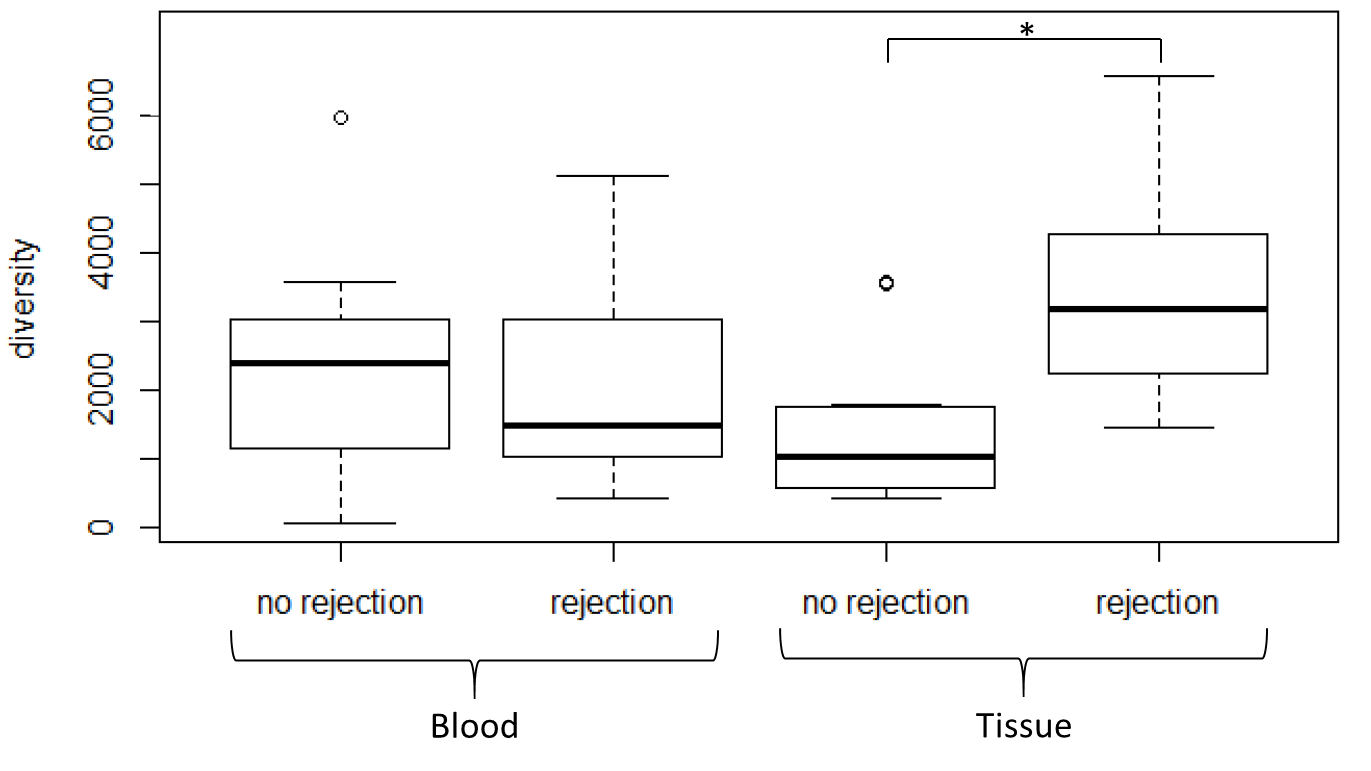T Cell Repertoire of Tissue Infiltrating T-cells at Time of Rejection
1Nephrology, Medical University of Vienna, Vienna, Austria, 2University of Applied Sciences Upper Austria, Hagenberg, Austria, 3Austrian Red Cross, Vienna, Austria
Meeting: 2019 American Transplant Congress
Abstract number: A2
Keywords: T cell clones
Session Information
Session Name: Poster Session A: Acute Rejection
Session Type: Poster Session
Date: Saturday, June 1, 2019
Session Time: 5:30pm-7:30pm
 Presentation Time: 5:30pm-7:30pm
Presentation Time: 5:30pm-7:30pm
Location: Hall C & D
*Purpose: Tissue infiltration of T-cells is the hallmark of acute cellular graft rejection. Next generation sequencing of T-cell receptors enables in depth analysis of the T-cell repertoire. We previously reported that expanded tissue infiltrating T-cell clones are highly correlated with the peripheral repertoire in various renal diseases. Here we characterized the repertoire of tissue infiltrating and peripheral T-cells in patients with biopsy confirmed acute cellular rejection (BCAR) and compared it to samples from stable controls with no rejection at time of management biopsy at one month following transplantation.
*Methods:
Tissue samples from kidney biopsy as well as peripheral blood samples from 20 patients were analyzed. Nine patients had BCAR within the first month and eleven patients with stable graft function and no sign of rejection at per protocol biopsy at one month were used as controls.DNA was extracted from peripheral blood and biopsy material. Rearranged V-(D)-J elements in the TCR-β locus were PCR amplified using the Biomed-2 primer panels and sequenced on an Illumina MiSeq. On average 346,886 paired-end reads were generated per sample. MiXCR was used to assemble clones from sequencing reads. In total 614,150 different clonotypes were identified in all samples. 270,669 and 354,093 different clonotypes were identified in blood and tissue samples, respectively. Repertoire diversity was calculated using the software framework ImmunExplorer.
*Results: The tissue infiltrating T-cell repertoire in patients with BCAR showed higher diversity levels and contained a higher number of distinct clonotypes compared to patients without rejection (p=0.002). The higher diversity levels remained significant after adjustment for the number of observed clones within each sample (Figure 1). The blood derived T-cell repertoire showed similar diversity levels and overall clonotype numbers between both groups (p=0.569). Similarity of the blood- and tissue-derived immune repertoire varied between individuals.
*Conclusions: The T-cell repertoire of tissue infiltrating T cells in BCAR is more diverse compared to the tissue-derived repertoire in patients without rejection suggesting infiltration of a high number of different T-cell clones. To differentiate alloreactive T-cell infiltration from non-alloreactive bystander T-cells, the alloantigen-specific T-cell repertoire needs to be defined.
Figure 1: Blood- and tissue-derived T-Cell repertoire diversity of patients with biopsy confirmed acute rejection and patients with no histological sign of rejection.
To cite this abstract in AMA style:
Reindl-Schwaighofer R, Vetter J, Weinberger J, Schaller S, Heinzel A, Gualdoni G, Aschauer C, Jelencsics K, Hu K, Winkler S, Oberbauer R. T Cell Repertoire of Tissue Infiltrating T-cells at Time of Rejection [abstract]. Am J Transplant. 2019; 19 (suppl 3). https://atcmeetingabstracts.com/abstract/t-cell-repertoire-of-tissue-infiltrating-t-cells-at-time-of-rejection/. Accessed December 29, 2025.« Back to 2019 American Transplant Congress

